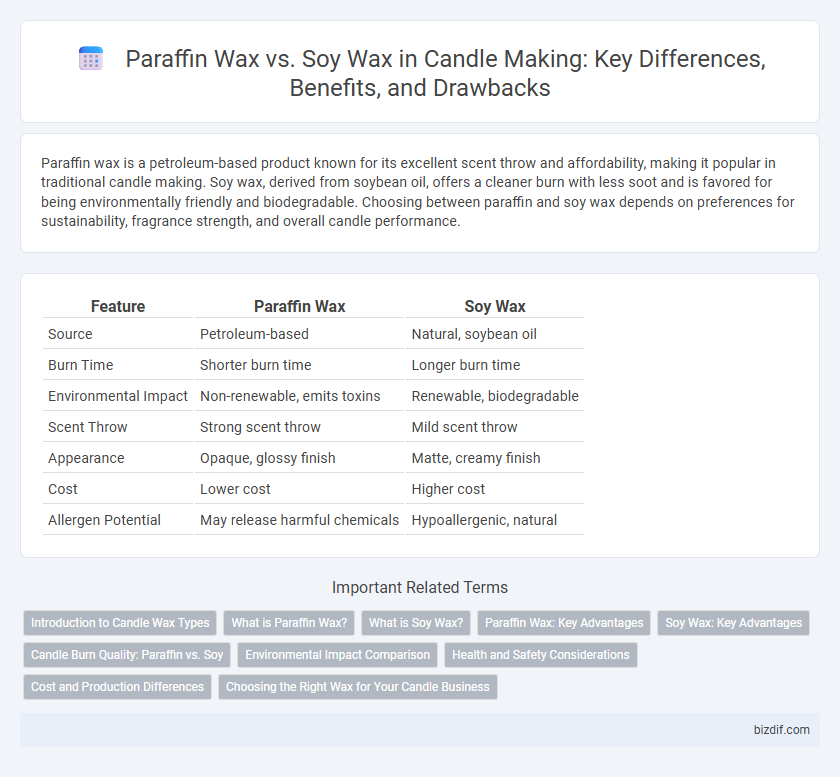Paraffin wax is a petroleum-based product known for its excellent scent throw and affordability, making it popular in traditional candle making. Soy wax, derived from soybean oil, offers a cleaner burn with less soot and is favored for being environmentally friendly and biodegradable. Choosing between paraffin and soy wax depends on preferences for sustainability, fragrance strength, and overall candle performance.
Table of Comparison
| Feature | Paraffin Wax | Soy Wax |
|---|---|---|
| Source | Petroleum-based | Natural, soybean oil |
| Burn Time | Shorter burn time | Longer burn time |
| Environmental Impact | Non-renewable, emits toxins | Renewable, biodegradable |
| Scent Throw | Strong scent throw | Mild scent throw |
| Appearance | Opaque, glossy finish | Matte, creamy finish |
| Cost | Lower cost | Higher cost |
| Allergen Potential | May release harmful chemicals | Hypoallergenic, natural |
Introduction to Candle Wax Types
Paraffin wax, derived from petroleum, is widely used in candle making for its ability to hold fragrance and color well, offering bright, consistent burns. Soy wax, a natural alternative made from soybean oil, provides cleaner combustion with minimal soot and longer burn times, appealing to eco-conscious consumers. Both wax types serve distinct purposes in candle production, influencing scent throw, burn quality, and environmental impact.
What is Paraffin Wax?
Paraffin wax is a petroleum-derived substance commonly used in candle making due to its affordable cost and excellent scent-holding capabilities. It melts at a relatively low temperature, providing a bright, consistent flame and smooth finish for candles. Despite its popularity, paraffin wax is non-renewable and can release toxins when burned, leading many makers to seek natural alternatives like soy wax.
What is Soy Wax?
Soy wax is a natural, biodegradable wax derived from soybean oil, prized for its clean-burning properties and renewable source. Unlike paraffin wax, which is petroleum-based, soy wax offers a sustainable alternative that produces less soot and holds fragrance oils better for a longer-lasting scent. Its lower melting point makes soy wax ideal for container candles, providing a smooth, creamy finish favored by many candle makers.
Paraffin Wax: Key Advantages
Paraffin wax offers superior scent throw and vibrant color retention, making it ideal for richly fragranced, colorful candles. Its low cost and consistent availability provide a budget-friendly option for both hobbyists and commercial candle makers. High melting point stability allows for longer-lasting, well-formed candles suitable for various molding techniques.
Soy Wax: Key Advantages
Soy wax offers significant benefits over paraffin wax, including its natural, renewable origin derived from soybeans, making it an eco-friendly option. It burns cleaner with minimal soot production, enhancing indoor air quality and reducing allergenic risks. Soy wax also has a longer burn time and better fragrance retention, creating a more consistent and enjoyable candle experience.
Candle Burn Quality: Paraffin vs. Soy
Paraffin wax candles typically burn brighter and produce a stronger scent throw due to their higher melting point and ability to hold fragrance oils effectively. Soy wax burns cleaner with less soot, resulting in a longer-lasting, more environmentally friendly flame that is ideal for indoor use. Choosing between paraffin and soy wax depends on the desired burn quality, with paraffin offering intense fragrance release and soy providing a smoother, more sustainable burn.
Environmental Impact Comparison
Paraffin wax, derived from petroleum, releases harmful toxins and carbon dioxide during burning, contributing significantly to environmental pollution. In contrast, soy wax is a renewable resource made from soybean oil, which is biodegradable and produces less soot and greenhouse gases. Choosing soy wax over paraffin supports sustainable agriculture and reduces the overall carbon footprint of candle production.
Health and Safety Considerations
Paraffin wax, derived from petroleum, releases potentially harmful chemicals such as toluene and benzene when burned, raising indoor air quality concerns and possible respiratory irritation. Soy wax, a natural vegetable wax made from soybean oil, burns cleaner with minimal soot production and fewer toxins, making it a safer choice for indoor environments. Both waxes require careful handling during melting to avoid burns and proper ventilation to reduce inhalation of vapors.
Cost and Production Differences
Paraffin wax, derived from petroleum, is typically less expensive and more widely produced than soy wax, which is made from renewable soybean oil. The cost advantage of paraffin wax comes from its large-scale industrial production and abundant availability, whereas soy wax production is limited by agricultural factors and seasonal soybean yields. Soy wax generally demands a higher price due to its natural origin and eco-friendly appeal, impacting overall candle-making expenses.
Choosing the Right Wax for Your Candle Business
Paraffin wax offers a cost-effective option with excellent scent retention and vibrant color results, making it popular for mass-produced candles. Soy wax provides a natural, eco-friendly alternative with cleaner burning and longer-lasting scents, appealing to environmentally conscious consumers. Selecting the right wax depends on your target market preferences, budget constraints, and desired candle performance.
Paraffin wax vs Soy wax Infographic

 bizdif.com
bizdif.com